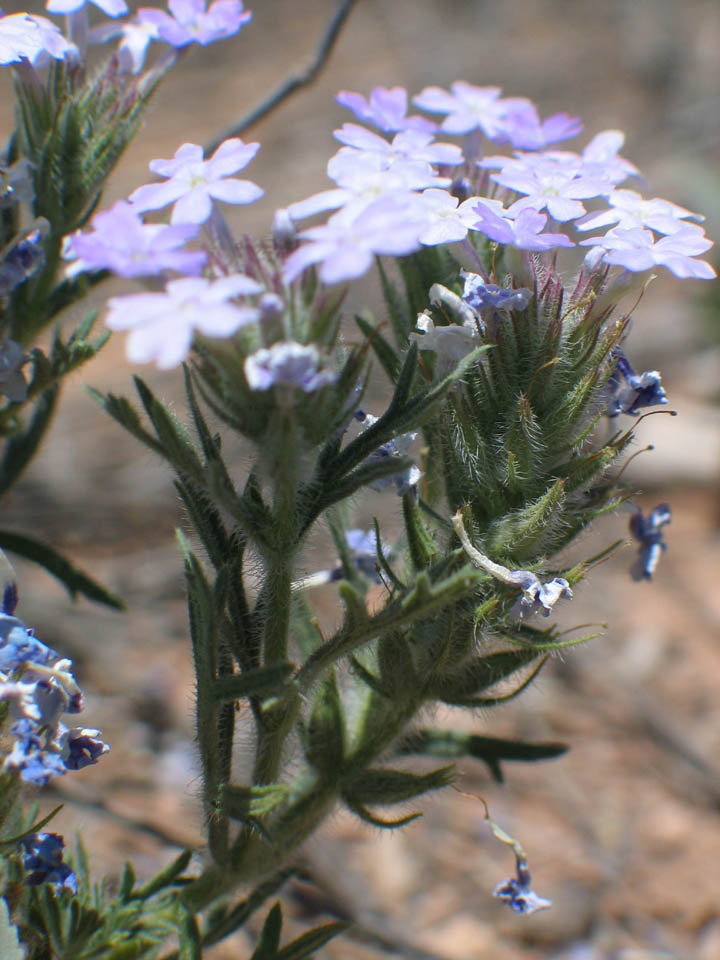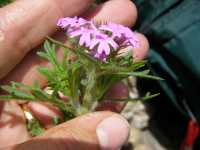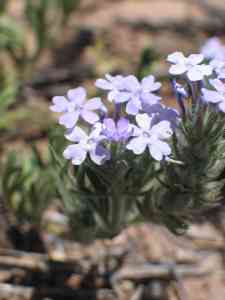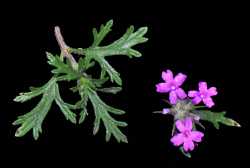|
|
|
|
Family: Verbenaceae
Dakota mock vervain
[Verbena bipinnatifida Schauer] |
Perennial herb 10 - 40 cm tall Stem: branched, bristly-hairy. Leaves: opposite, stalked, 2 - 6 cm long, incompletely pinnate with clefts not reaching midvein (pinnatifid) or three-parted with more or less twice pinnatifid segments, stiff-haired. Flowers: borne on spikes, with linear-awl-shaped bracts usually longer than the calyx, a 8.5 - 10 mm long calyx with unequal slender lobes and bristly hairs along veins, and a pink to purple corolla tube one and a half times as long as the calyx with notched lobes. Fruit: four nutlets, each 3 mm long. Similar species: Glandularia species have a five-lobed calyx at least 8 mm in length, a corolla at least 1 cm long, and fruit separating into four nutlets. Glandularia canadensis and Glandularia peruviana differ by having a corolla tube twice as long as the calyx and bracts that are usually shorter than the calyx. In addition, G. canadensis has long bristle-like calyx lobes, and G. peruviana has short triangular calyx lobes. Flowering: May to August Habitat and ecology: This species was introduced from the western United States but is rare in the Chicago Region. One voucher was collected along a railroad. Occurence in the Chicago region: non-native Etymology: Glandularia means "with small glands." Bipinnatifida means "twice pinnately dissected," referring to the leaves. Author: The Morton Arboretum Diffusely branched perennial 1-4 dm, the stems hispid- hirsute, the lvs appressed-hirsute, the cal hispid-hirsute along the nerves; lvs petiolate, 2-6 cm, pinnatifid, or ternate with ±bipinnatifid segments; spikes pedunculate, short at anthesis, later elongating; bracts linear- subulate, mostly longer than the cal; cal 8.5-10 mm, the slender lobes unequal; cor pink to purple, the tube half again as long as the cal, the limb 7-10 mm wide, the lobes emarginate; nutlets 3 mm; 2n=30. Dry plains and other open places; S.D. to Ariz. and La., barely entering our range in nw. Mo. Feb.-Dec. Gleason, Henry A. & Cronquist, Arthur J. 1991. Manual of vascular plants of northeastern United States and adjacent Canada. lxxv + 910 pp. ©The New York Botanical Garden. All rights reserved. Used by permission. Martin and Hutchins 1980, Kearney and Peebles 1969, Correll and Johnston 1979, Heil et al 2013, Allred and Ivey 2012 Duration: Perennial Nativity: Native Lifeform: Forb/Herb General: Annual to perennial herb, 15-30 cm tall; stems diffusely branched from near base, ascending, sometimes rooting from the lower nodes; herbage hispid-hirsute. Leaves: Opposite and petiolate; blades deeply incised to bipinnately lobed, 2-6 cm long, the lobes linear or oblong, margins often revolute, both surfaces appressed-hirsute. Flowers: Purple and showy, in short, dense terminal spikes; each flower subtended by a linear-subulate bractlet longer than the calyx; calyx 8-10 mm long, hirsute, with inequal teeth, constricted or contorted above the nutlets at maturity; corolla pink to purple, salverform, longer than the calyx, the tube 8-13 mm long, the limb 8-10 mm wide. Fruits: Nutlets 4, enclosed in calyx. Ecology: Found in rocky to sandy soils, in open woods, wash bottoms, and stream margins, from 2,000-10,000 ft (610-3048 m); flowers May-September. Distribution: SD to MO and AL, west to CO and AZ; south to n MEX. Also in cultivation. Notes: This fairly common perennial is hard to miss with its showy, nectiferous purple flowers and hairy, pinnately lobed leaves. It is distinguished from other Glandularia, especially G. gooddingii, by the floral bracts being slightly longer than the calyx, and the herbage being hirsute, and not glandular. There are a number of varieties which have been recognized as distinct species at one time or another. Neesom (2010) completed a treatment for the complex, some of which was incorporated into Allred and Ivey (2012) but differences amonth the taxa are subtle. Ethnobotany: Leaves rubbed on snakebites; used to make a gargle for sore throat and as a life medicine. Etymology: Glandularia is from the Latin gland, probably referring to the glandular pubescence of many species, while bipinnatifida refers to the twice-pinnate leaves. Synonyms: Verbena ambrosiifolia, V. bipinnitifida, V. bipinnatifida var. brevispicata Editor: SBuckley 2010, AHazelton 2015 |





